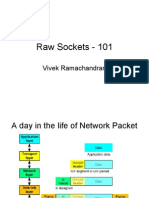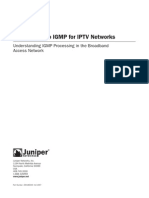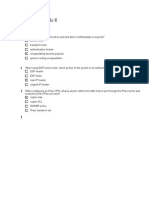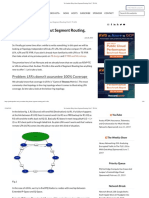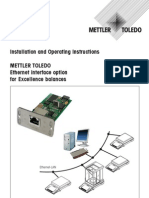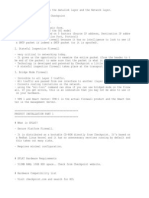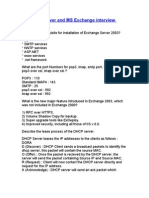0 ratings0% found this document useful (0 votes)
145 viewsBGP Packet Format
BGP Packet Format
Uploaded by
saravanan_murugesa_1The document summarizes the Border Gateway Protocol (BGP), which performs interdomain routing between autonomous systems on the internet. BGP maintains routing tables and exchanges routing information with peer routers to help routers have a consistent view of the network topology. BGP uses TCP to ensure reliable delivery of routing updates between routers and determines the best path to a network based on a metric assigned by the network administrator, such as number of autonomous systems or link stability.
Copyright:
© All Rights Reserved
Available Formats
Download as PDF, TXT or read online from Scribd
BGP Packet Format
BGP Packet Format
Uploaded by
saravanan_murugesa_10 ratings0% found this document useful (0 votes)
145 views8 pagesThe document summarizes the Border Gateway Protocol (BGP), which performs interdomain routing between autonomous systems on the internet. BGP maintains routing tables and exchanges routing information with peer routers to help routers have a consistent view of the network topology. BGP uses TCP to ensure reliable delivery of routing updates between routers and determines the best path to a network based on a metric assigned by the network administrator, such as number of autonomous systems or link stability.
Original Description:
BGP PDU formats
Original Title
Bgp Packet Format
Copyright
© © All Rights Reserved
Available Formats
PDF, TXT or read online from Scribd
Share this document
Did you find this document useful?
Is this content inappropriate?
The document summarizes the Border Gateway Protocol (BGP), which performs interdomain routing between autonomous systems on the internet. BGP maintains routing tables and exchanges routing information with peer routers to help routers have a consistent view of the network topology. BGP uses TCP to ensure reliable delivery of routing updates between routers and determines the best path to a network based on a metric assigned by the network administrator, such as number of autonomous systems or link stability.
Copyright:
© All Rights Reserved
Available Formats
Download as PDF, TXT or read online from Scribd
Download as pdf or txt
0 ratings0% found this document useful (0 votes)
145 views8 pagesBGP Packet Format
BGP Packet Format
Uploaded by
saravanan_murugesa_1The document summarizes the Border Gateway Protocol (BGP), which performs interdomain routing between autonomous systems on the internet. BGP maintains routing tables and exchanges routing information with peer routers to help routers have a consistent view of the network topology. BGP uses TCP to ensure reliable delivery of routing updates between routers and determines the best path to a network based on a metric assigned by the network administrator, such as number of autonomous systems or link stability.
Copyright:
© All Rights Reserved
Available Formats
Download as PDF, TXT or read online from Scribd
Download as pdf or txt
You are on page 1of 8
C H A P T E R
Border Gateway Protocol (BGP) 35-1
3 5
Border Gateway Protocol (BGP)
Background
Routing involves two basic activities: determination of optimal routing paths and the transport of
information groups (typically called packets) through an internetwork. The transport of packets
through an internetwork is relatively straightforward. Path determination, on the other hand, can be
very complex. One protocol that addresses the task of path determination in todays networks is the
Border Gateway Protocol (BGP). This chapter summarizes the basic operations of BGP and
provides a description of its protocol components.
BGP performs interdomain routing in Transmission-Control Protocol/Internet Protocol (TCP/IP)
networks. BGP is an exterior gateway protocol (EGP), which means that it performs routing between
multiple autonomous systems or domains and exchanges routing and reachability information with
other BGP systems.
BGP was developed to replace its predecessor, the now obsolete Exterior Gateway Protocol (EGP),
as the standard exterior gateway-routing protocol used in the global Internet. BGP solves serious
problems with EGP and scales to Internet growth more efciently.
Note EGP is a particular instance of an exterior gateway protocol (also EGP)the two should not
be confused.
Figure 35-1 illustrates core routers using BGP to route trafc between autonomous systems.
Figure 35-1 Core routers can use BGP to route trafc between autonomous systems.
BGP is specied in several Request For Comments (RFCs):
RFC 1771Describes BGP4, the current version of BGP
Core Router
BGP BGP BGP
Autonomous Systems
BGP BGP BGP
Core Router Core Router
1
2
3
6
0
BGP Operation
Internetworking Technology Overview, June 1999 35-2
RFC 1654Describes the rst BGP4 specication
RFC 1105, RFC 1163, and RFC 1267Describes versions of BGP prior to BGP4
BGP Operation
BGP performs three types of routing: interautonomous system routing, intra-autonomous system
routing, and pass-through autonomous system routing.
Interautonomous system routing occurs between two or more BGP routers in different autonomous
systems. Peer routers in these systems use BGP to maintain a consistent view of the internetwork
topology. BGP neighbors communicating between autonomous systems must reside on the same
physical network. The Internet serves as an example of an entity that uses this type of routing
because it is comprised of autonomous systems or administrative domains. Many of these domains
represent the various institutions, corporations, and entities that make up the Internet. BGP is
frequently used to provide path determination to provide optimal routing within the Internet.
Intra-autonomous system routing occurs between two or more BGP routers located within the same
autonomous system. Peer routers within the same autonomous system use BGP to maintain a
consistent viewof the systemtopology. BGP also is used to determine which router will serve as the
connection point for specic external autonomous systems. Once again, the Internet provides an
example of interautonomous system routing. An organization, such as a university, could make use
of BGP to provide optimal routing within its own administrative domain or autonomous system. The
BGP protocol can provide both inter- and intra-autonomous system routing services.
Pass-through autonomous system routing occurs between two or more BGP peer routers that
exchange trafc across an autonomous systemthat does not run BGP. In a pass-through autonomous
systemenvironment, the BGP trafc did not originate within the autonomous systemin question and
is not destined for a node in the autonomous system. BGP must interact with whatever
intra-autonomous system routing protocol is being used to successfully transport BGP trafc
through that autonomous system. Figure 35-2 illustrates a pass-through autonomous system
environment:
Figure 35-2 In pass-through autonomous system routing, BGP pairs with another
intra-autonomous system-routing protocol.
Source
Destination
BGP
Pass-Through
Autonomous System
1
2
3
6
1
Intra-Autonomous
System Protocol
BGP
Border Gateway Protocol (BGP) 35-3
BGP Routing
BGP Routing
As with any routing protocol, BGP maintains routing tables, transmits routing updates, and bases
routing decisions on routing metrics. The primary function of a BGP system is to exchange
network-reachability information, including information about the list of autonomous systempaths,
with other BGP systems. This information can be used to construct a graph of autonomous system
connectivity from which routing loops can be pruned and with which autonomous system-level
policy decisions can be enforced.
Each BGP router maintains a routing table that lists all feasible paths to a particular network. The
router does not refresh the routing table, however. Instead, routing information received from peer
routers is retained until an incremental update is received.
BGP devices exchange routing information upon initial data exchange and after incremental
updates. When a router rst connects to the network, BGP routers exchange their entire BGP routing
tables. Similarly, when the routing table changes, routers send the portion of their routing table that
has changed. BGP routers do not send regularly scheduled routing updates, and BGP routing updates
advertise only the optimal path to a network.
BGP uses a single routing metric to determine the best path to a given network. This metric consists
of an arbitrary unit number that species the degree of preference of a particular link. The BGP
metric typically is assigned to each link by the network administrator. The value assigned to a link
can be based on any number of criteria, including the number of autonomous systems through which
the path passes, stability, speed, delay, or cost.
BGP Message Types
Four BGP message types are specied in RFC 1771, A Border Gateway Protocol 4 (BGP-4): open
message, update message, notication message, and keep-alive message.
The open message opens a BGP communications session between peers and is the rst message sent
by each side after a transport-protocol connection is established. Open messages are conrmed using
a keep-alive message sent by the peer device and must be conrmed before updates, notications,
and keep-alives can be exchanged.
An update message is used to provide routing updates to other BGP systems, allowing routers to
construct a consistent view of the network topology. Updates are sent using the
Transmission-Control Protocol (TCP) to ensure reliable delivery. Update messages can withdraw
one or more unfeasible routes fromthe routing table and simultaneously can advertise a route while
withdrawing others.
The notication message is sent when an error condition is detected. Notications are used to close
an active session and to inform any connected routers of why the session is being closed.
The keep-alive message noties BGP peers that a device is active. Keep-alives are sent often enough
to keep the sessions from expiring.
BGP Packet Formats
The sections that followsummarize BGP open, updated, notication, and keep-alive message types,
as well as the basic BGP header format. Each is illustrated with a format drawing, and the elds
shown are dened.
BGP Packet Formats
Internetworking Technology Overview, June 1999 35-4
Header Format
All BGP message types use the basic packet header. Open, update, and notication messages have
additional elds, but keep-alive messages use only the basic packet header. Figure 35-3 illustrates
the elds used in the BGP header. The section that follows summarizes the function of each eld.
Figure 35-3 A BGP packet header consists of four elds.
BGP Packet-Header Fields
Each BGP packet contains a header whose primary purpose is to identify the function of the packet
in question. The following descriptions summarize the function of each eld in the BGP header
illustrated in Figure 35-3.
MarkerContains an authentication value that the message receiver can predict.
LengthIndicates the total length of the message in bytes.
TypeType Species the message type as one of the following:
Open
Update
Notication
Keep-alive
DataContains upper-layer information in this optional eld.
Open Message Format
BGP open messages are comprised of a BGP header and additional elds. Figure 35-4 illustrates the
additional elds used in BGP open messages.
Figure 35-4 A BGP open message consists of six elds.
Marker Length Data
Field Length,
in Bytes
16 2 Variable
Type
1
i
t
h
3
3
0
3
Version
Autonomous
System
Field Length,
in Bytes
1 2 2 4 1 4
Hold-Time
BGP
Identifier
Optional
Parameters
Optional
Parameters
Length
i
t
h
3
3
0
4
Border Gateway Protocol (BGP) 35-5
Update Message Format
BGP Open Message Fields
BGP packets in which the type eld in the header identies the packet to be a BGP open message
packet include the following elds. These elds provide the exchange criteria for two BGP routers
to establish a peer relationship.
VersionProvides the BGP version number so that the recipient can determine whether it is
running the same version as the sender.
Autonomous SystemProvides the autonomous system number of the sender.
Hold-TimeIndicates the maximum number of seconds that can elapse without receipt of a
message before the transmitter is assumed to be nonfunctional.
BGP IdentierProvides the BGP identier of the sender (an IP address), which is determined
at startup and is identical for all local interfaces and all BGP peers.
Optional Parameters LengthIndicates the length of the optional parameters eld (if present).
Optional ParametersContains a list of optional parameters (if any). Only one optional
parameter type is currently dened: authentication information.
Authentication information consists of the following two elds:
Authentication code: Indicates the type of authentication being used.
Authentication data: Contains data used by the authentication mechanism (if used).
Update Message Format
BGP update messages are comprised of a BGP header and additional elds. Figure 35-5 illustrates
the additional elds used in BGP update messages.
Figure 35-5 A BGP update message contains ve elds.
BGP Update Message Fields
BGP packets in which the type eld in the header identies the packet to be a BGP update message
packet include the following elds. Upon receiving an update message packet, routers will be able
to add or delete specic entries fromtheir routing tables to ensure accuracy. Update messages consist
of the following packets:
Unfeasible Routes LengthIndicates the total length of the withdrawn routes eld or that the
eld is not present.
Withdrawn RoutesContains a list of IP address prexes for routes being withdrawn from
service.
Total Path Attribute LengthIndicates the total length of the path attributes eld or that the eld
is not present.
Withdrawn
Routes
Field Length,
in Bytes
2 Variable 2 Variable Variable
Path
Attributes
Network Layer
Reachability
Information
Unfeasible
Routes
Length
Total Path
Attribute
Length
i
t
h
3
3
0
5
BGP Packet Formats
Internetworking Technology Overview, June 1999 35-6
Path AttributesDescribes the characteristics of the advertised path. The following are possible
attributes for a path:
Origin: Mandatory attribute that denes the origin of the path information
AS Path: Mandatory attribute composed of a sequence of autonomous systempath segments
Next Hop: Mandatory attribute that denes the IP address of the border router that should be
used as the next hop to destinations listed in the network layer reachability information eld
Mult Exit Disc: Optional attribute used to discriminate between multiple exit points to a
neighboring autonomous system
Local Pref: Discretionary attribute used to specify the degree of preference for an advertised
route
Atomic Aggregate: Discretionary attribute used to disclose information about route
selections
Aggregator: Optional attribute that contains information about aggregate routes
Network Layer Reachability InformationContains a list of IP address prexes for the
advertised routes
Notication Message Format
Figure 35-6 illustrates the additional elds used in BGP notication messages.
Figure 35-6 A BGP notication message consists of three elds.
BGP Notication Message Fields
BGP packets in which the type eld in the header identies the packet to be a BGP notication
message packet include the following elds. This packet is used to indicate some sort of error
condition to the peers of the originating router.
Error CodeIndicates the type of error that occurred. The following are the error types dened
by the eld:
Message Header Error: Indicates a problem with a message header, such as unacceptable
message length, unacceptable marker eld value, or unacceptable message type.
Open Message Error: Indicates a problem with an open message, such as unsupported
version number, unacceptable autonomous system number or IP address, or unsupported
authentication code.
Update Message Error: Indicates a problem with an update message, such as a malformed
attribute list, attribute list error, or invalid next-hop attribute.
Error Code Error Subcode
Field Length,
in Bytes
1 1 Variable
Error Data
i
t
h
3
3
0
6
Border Gateway Protocol (BGP) 35-7
Notification Message Format
Hold Time Expired: Indicates that the hold-time has expired, after which time a BGP node
will be considered nonfunctional.
Finite State Machine Error: Indicates an unexpected event.
Cease: Closes a BGP connection at the request of a BGP device in the absence of any fatal
errors.
Error SubcodeProvides more specic information about the nature of the reported error.
Error DataContains data based on the error code and error subcode elds. This eld is used to
diagnose the reason for the notication message.
BGP Packet Formats
Internetworking Technology Overview, June 1999 35-8
Pulse Supply - www.pulsesupply.com Toll Free: 1-888-785-7393 - Int'l: 1-951-694-1173 sales@pulsesupply.com
You might also like
- Routing ProtocolsDocument51 pagesRouting ProtocolstalmeezNo ratings yet
- BRKSPG-2003 - Internet PeeringDocument96 pagesBRKSPG-2003 - Internet PeeringquintaNo ratings yet
- Introduction To FRRoutingDocument74 pagesIntroduction To FRRoutingO'Neil RobinsonNo ratings yet
- CCIE Collaboration Quick ReferenceDocument315 pagesCCIE Collaboration Quick ReferenceCanhCuaCàMuốiNo ratings yet
- CloudVision Integration With NSXDocument6 pagesCloudVision Integration With NSXamit_waghmaleNo ratings yet
- MPLSo UDPDocument3 pagesMPLSo UDPChristian Ella100% (1)
- Arbor Networks Help - Configuring Loopback Interfaces PDFDocument2 pagesArbor Networks Help - Configuring Loopback Interfaces PDFab_laaroussiNo ratings yet
- Simpleworkflow in The Cloud: Poa June 17, 2010 Alan Robbins and Rick SearsDocument99 pagesSimpleworkflow in The Cloud: Poa June 17, 2010 Alan Robbins and Rick SearsmanedeepNo ratings yet
- 1 Openstack Neutron Distributed Virtual RouterDocument11 pages1 Openstack Neutron Distributed Virtual RouterShabeer UppotungalNo ratings yet
- Using A Full Table RR To Improve EBGP Performance With Mikrotik RoutersDocument26 pagesUsing A Full Table RR To Improve EBGP Performance With Mikrotik RoutersildefonsoNo ratings yet
- DV Co1 All PDFDocument196 pagesDV Co1 All PDFminniNo ratings yet
- KevinDocument35 pagesKevinNaingWinOoNo ratings yet
- Congestion ControlDocument26 pagesCongestion ControlElliott BinderNo ratings yet
- Mikrotik Data Center MUM 2014 KevinMyers 4 by 3Document31 pagesMikrotik Data Center MUM 2014 KevinMyers 4 by 3Maryudi Uchiha Mundane Person0% (1)
- Linux PatchDocument3 pagesLinux PatchRauzaa PathanNo ratings yet
- Configuring The SRX300 Services Gateway Using The CLIDocument3 pagesConfiguring The SRX300 Services Gateway Using The CLIherusuparsinNo ratings yet
- Deployment of Private Hybrid Public Clouds With OpennebulaDocument23 pagesDeployment of Private Hybrid Public Clouds With OpennebulaAlephNullNo ratings yet
- 05 BGP BCP PDFDocument93 pages05 BGP BCP PDFveera bhadraNo ratings yet
- Raw SocketsDocument15 pagesRaw Socketsarunodoy_dasgupta3078No ratings yet
- Resultatjour DepartementauxDocument13 pagesResultatjour Departementauxdicas11No ratings yet
- 10 KM GeneralDocument6 pages10 KM GeneralPierre DestradeNo ratings yet
- Basic Linux ArchitectureDocument11 pagesBasic Linux ArchitectureJyothy LakshuNo ratings yet
- Using Mikrotik CHR As A BGP Edge RouterDocument32 pagesUsing Mikrotik CHR As A BGP Edge Routercardenascc100% (1)
- Xeon D 1500 Thermal GuideDocument82 pagesXeon D 1500 Thermal GuidedigitalsureshNo ratings yet
- AthletesDocument494 pagesAthletesLuis CarlosNo ratings yet
- BER Bit Error Rate Tutorial and DefinitionDocument5 pagesBER Bit Error Rate Tutorial and DefinitionঅচেনাবিকেলNo ratings yet
- Nasuni 2015 State of Cloud Storage ReportDocument13 pagesNasuni 2015 State of Cloud Storage ReportfedericosanchezNo ratings yet
- 07 Simple MultihomingDocument107 pages07 Simple MultihomingChazzy CanjaNo ratings yet
- Chapter 1 Introduction To Network ManagementDocument24 pagesChapter 1 Introduction To Network ManagementNik IkhwanNo ratings yet
- Interview QuestionsDocument7 pagesInterview QuestionsaimslifeNo ratings yet
- Reverse Engineering Drop BoxDocument7 pagesReverse Engineering Drop Boxblue42zNo ratings yet
- Atos Hiring For Network Engineer (Routing, Switching, Firewall, F5 LB)Document3 pagesAtos Hiring For Network Engineer (Routing, Switching, Firewall, F5 LB)Niraj Kumar MauryaNo ratings yet
- How To Whitelist Hosts - IP Addresses in PostfixDocument3 pagesHow To Whitelist Hosts - IP Addresses in PostfixStrike WardonoNo ratings yet
- Howto Configure A Mikrotik As Central DHCP Server With Switches As DHCP Relays - Robert Penz BlogDocument15 pagesHowto Configure A Mikrotik As Central DHCP Server With Switches As DHCP Relays - Robert Penz BlogAnonymous dLqSSVXbScNo ratings yet
- 1508 NPM Integration-Guide PDFDocument27 pages1508 NPM Integration-Guide PDFlaaguidnet100% (1)
- Iperf Jperf Document PDFDocument11 pagesIperf Jperf Document PDFNirmal KumarNo ratings yet
- Cumulus Certification Blueprint 03.1Document4 pagesCumulus Certification Blueprint 03.1jaimealcarriaNo ratings yet
- Ipv 6Document24 pagesIpv 6Mohamed Khalid R. JubaraNo ratings yet
- Anatomy of A Linux BridgeDocument6 pagesAnatomy of A Linux BridgeRashmi NambiarNo ratings yet
- Cloud ComputingDocument4 pagesCloud ComputingChuru iddyNo ratings yet
- Juniper IGMPDocument12 pagesJuniper IGMPmielucaNo ratings yet
- NPT1022 Family Data Sheet (DS)Document7 pagesNPT1022 Family Data Sheet (DS)Khanh Le DuyNo ratings yet
- Design The Application Architecture: Preparation ResourcesDocument3 pagesDesign The Application Architecture: Preparation ResourcesGabriel Lynch100% (1)
- Advanced Policy Lab Activities GuideDocument15 pagesAdvanced Policy Lab Activities GuideTestla GavanNo ratings yet
- 7 Network Programmability ConceptsDocument48 pages7 Network Programmability ConceptsKv142 KvNo ratings yet
- Junos Installation USB en SWDocument3 pagesJunos Installation USB en SWJose Miguel GuzmanNo ratings yet
- MP l2 Vpns Xe 3s Asr920 BookDocument204 pagesMP l2 Vpns Xe 3s Asr920 BookR.K. ThapaNo ratings yet
- Assignment-3: Nandikaa 19BCE2461 1) CodeDocument33 pagesAssignment-3: Nandikaa 19BCE2461 1) CodeMajety S LskshmiNo ratings yet
- Configuring and Troubleshooting Tcp/IpDocument60 pagesConfiguring and Troubleshooting Tcp/IpOle JonasNo ratings yet
- PacNOG12 IXP NetworkDesignDocument46 pagesPacNOG12 IXP NetworkDesignhusseinsadek7097No ratings yet
- Docker CLI Reference DocumentationDocument1,151 pagesDocker CLI Reference DocumentationJony NguyễnNo ratings yet
- BDIX Peering Policy-01Document2 pagesBDIX Peering Policy-01Eshaan NurNo ratings yet
- CCNA Security Module 8Document8 pagesCCNA Security Module 8Akbal Larios0% (1)
- Inter-Domain Routing: OutlineDocument15 pagesInter-Domain Routing: OutlineAmaan RahimNo ratings yet
- Explain BGP ?Document3 pagesExplain BGP ?Pravesh KumarNo ratings yet
- Yet Another Blog About Segment Routing, Part2 - TI-LFADocument18 pagesYet Another Blog About Segment Routing, Part2 - TI-LFAnannuNo ratings yet
- CAMEL: Intelligent Networks for the GSM, GPRS and UMTS NetworkFrom EverandCAMEL: Intelligent Networks for the GSM, GPRS and UMTS NetworkRating: 2 out of 5 stars2/5 (1)
- Saad Lab5 CNDocument3 pagesSaad Lab5 CNmundacharsi447No ratings yet
- CCNA3 v7 - ENSA - CCNA (200-301) - CCNA Certification Practice Exam Answers - InfraExam 2021Document32 pagesCCNA3 v7 - ENSA - CCNA (200-301) - CCNA Certification Practice Exam Answers - InfraExam 2021sofiene DachNo ratings yet
- 1.5.1.3EWAN Packet Tracer 1Document26 pages1.5.1.3EWAN Packet Tracer 1Wozi WozNo ratings yet
- Network Fundamentals: Abdelkhalik Elsaid MosaDocument27 pagesNetwork Fundamentals: Abdelkhalik Elsaid MosaMona AliNo ratings yet
- Configure The l2 Multicast in AciDocument7 pagesConfigure The l2 Multicast in AciThuan NguyenNo ratings yet
- VLSM Examination 3cDocument2 pagesVLSM Examination 3cGlennOpleAvendaño100% (1)
- Network Error: Connection Timed Out: R SDocument15 pagesNetwork Error: Connection Timed Out: R SalidemonNo ratings yet
- Datasheet WiJungle U350VXDocument2 pagesDatasheet WiJungle U350VXSaiKrishna BoyapallyNo ratings yet
- Assignment 2024Document2 pagesAssignment 2024chamarasupun998No ratings yet
- BSCI Lab 13 PDFDocument8 pagesBSCI Lab 13 PDFJoko HandoyoNo ratings yet
- Network Management SystemDocument14 pagesNetwork Management Systemkunal bhargavaNo ratings yet
- EIGRP Troubleshooting Sim CCNA 200-125 Packet Tracer PKADocument6 pagesEIGRP Troubleshooting Sim CCNA 200-125 Packet Tracer PKASaudDanishNo ratings yet
- Module 04 - Answered (97 (1) .6%)Document4 pagesModule 04 - Answered (97 (1) .6%)Vantung DangNo ratings yet
- Exam 70-410: Installing and Configuring Windows Server 2012Document4 pagesExam 70-410: Installing and Configuring Windows Server 2012সাখাওয়াত হোসেনNo ratings yet
- Vendor: Microsoft Exam Code: 70-411 Exam Name: Administering Windows Server 2012 R2 ExamDocument401 pagesVendor: Microsoft Exam Code: 70-411 Exam Name: Administering Windows Server 2012 R2 Examdezrt_rozNo ratings yet
- Literature 2007 02Document5 pagesLiterature 2007 02rkkothaNo ratings yet
- Excellence Ethernet BA e 11780579ADocument32 pagesExcellence Ethernet BA e 11780579Anirgal76No ratings yet
- PT-508 Series - Layer 2 Managed Switches - MOXADocument1 pagePT-508 Series - Layer 2 Managed Switches - MOXABoudam BoudjemaNo ratings yet
- Checkpoint CCSA (CBT)Document3 pagesCheckpoint CCSA (CBT)asegunloluNo ratings yet
- Cisco Nexus Dashboard and Services Deployment Guide 311Document194 pagesCisco Nexus Dashboard and Services Deployment Guide 311RushikeshNo ratings yet
- Interview Questions and AnswerDocument2 pagesInterview Questions and Answerabstrakt1185No ratings yet
- Nmap ScriptsDocument52 pagesNmap ScriptsAzaz Ahmed Dobiwala100% (1)
- Template Config Tdm-Ip Acx1000 MLMT 19092019-V1Document336 pagesTemplate Config Tdm-Ip Acx1000 MLMT 19092019-V1lamvan tuNo ratings yet
- IOS XR BGP Commands PDFDocument420 pagesIOS XR BGP Commands PDFTylorKytasaariNo ratings yet
- 07 CaptivePortal PDFDocument21 pages07 CaptivePortal PDFRizha YuherdiantoNo ratings yet
- Task 1: Use NETCONF Via SSHDocument6 pagesTask 1: Use NETCONF Via SSHIonut StanciuNo ratings yet
- Infoblox Deployment Guide Implementing Infoblox Dns Traffic Control in Nios 8 XDocument59 pagesInfoblox Deployment Guide Implementing Infoblox Dns Traffic Control in Nios 8 Xmsaeed.tawfiek2No ratings yet
- Windows Server and MS Exchange Interview QuestionsDocument6 pagesWindows Server and MS Exchange Interview QuestionsPandianNo ratings yet




















